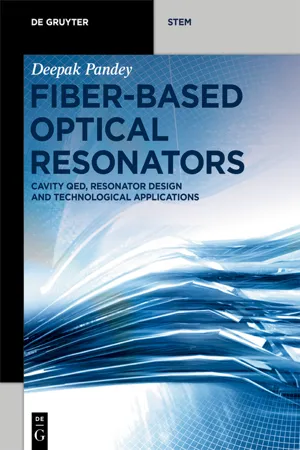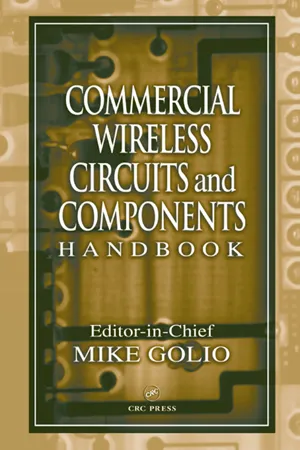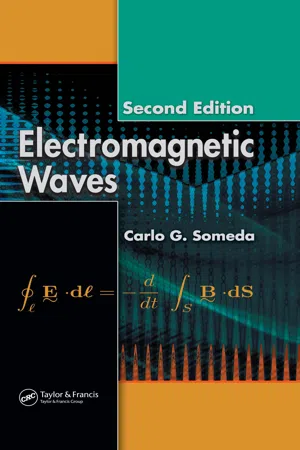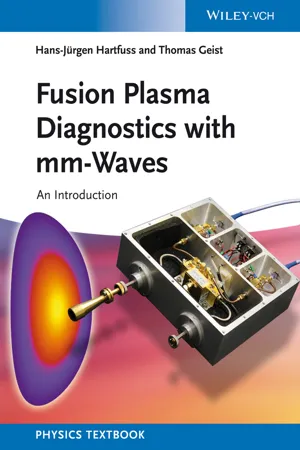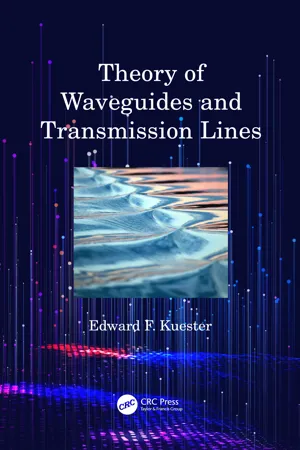Physics
TE Mode
TE mode refers to a type of electromagnetic wave propagation in a waveguide, where the electric field is transverse (perpendicular) to the direction of wave propagation. In this mode, there is no electric field component parallel to the direction of propagation. TE mode is characterized by a cutoff frequency, below which the mode cannot propagate in the waveguide.
Written by Perlego with AI-assistance
Related key terms
Related key terms
1 of 4
Related key terms
1 of 3
6 Key excerpts on "TE Mode"
- eBook - ePub
Fiber-Based Optical Resonators
Cavity QED, Resonator Design and Technological Applications
- Deepak Pandey(Author)
- 2024(Publication Date)
- De Gruyter(Publisher)
A waveguide is a structure or device used to guide and confine electromagnetic waves along a specific path. It is designed to propagate and control the transmission of electromagnetic energy, typically in the form of microwaves or radio waves. Waveguides are commonly used in various fields, including telecommunications, radar systems, microwave engineering, and high-frequency applications. Waveguides are typically constructed as hollow metallic or dielectric tubes, although other shapes and materials can be used depending on the specific requirements. The inner walls of the waveguide are highly reflective to the electromagnetic waves, allowing them to bounce back and forth within the waveguide without significant energy loss. This reflection is often achieved through the principle of total internal reflection, where the waveguide walls act as mirrors for the waves. The main purpose of a waveguide is to provide a controlled pathway for electromagnetic waves, allowing them to be efficiently transmitted, directed, and manipulated. By confining the waves within the waveguide, they can be guided over long distances while minimizing losses due to radiation and external interference. Waveguides support the propagation of different modes, which represent distinct patterns of electric and magnetic fields within the structure. These modes depend on the geometry, dimensions, and boundary conditions of the waveguide. The selection of a specific mode depends on the desired performance and functionality of the waveguide system.Waveguide modes refer to the different possible patterns of electromagnetic wave propagation within a waveguide. The modes of a waveguide are distinct patterns of electric and magnetic fields that can exist within the waveguide. These modes are characterized by their unique field distributions and corresponding propagation characteristics. The number and types of modes depend on the geometry and dimensions of the waveguide. Here are some key concepts related to waveguide modes.TE-modes are electromagnetic wave modes in which the electric field is purely transverse (perpendicular) to the direction of propagation. In these modes, the magnetic field has both transverse and longitudinal components. The subscript “m,n” is used to represent the mode indices, where “m” denotes the number of half-wavelength variations of the electric field across the width of the waveguide, and “n” represents the number of half-wavelength variations along the length.TM-modes are electromagnetic wave modes in which the magnetic field is purely transverse to the direction of propagation. In these modes, the electric field has both transverse and longitudinal components. Similar to TE Modes, the mode indices “m,n” are used to represent the variations of the magnetic field across the width and length of the waveguide.Hybrid modes, also known as TE-TM modes or EH-modes, have both electric and magnetic field components in both transverse and longitudinal directions. These modes possess characteristics of both TE and TM modes and are generally more complex in nature. - Mike Golio(Author)
- 2018(Publication Date)
- CRC Press(Publisher)
z , where propagation is in the z direction. The most common classifications are TE (Transverse Electric), TM (Transverse Magnetic), EH, and HE modes. The basic characteristics are described in the next two paragraphs. The TEM modes that were discussed in the previous section do not propagate in this type of metallic enclosed waveguide. This is because a TEM mode requires two conductors to propagate, where a conventional enclosed waveguide has only a single enclosing conductor.The two most common waveguide modes are the TE and TM modes. TE Modes have no component of E in the z direction, which means that E is completely transverse to the direction of propagation. Similarly, TM modes have no component of H in the z direction.EH and HE modes are hybrid modes that may be present under certain conditions, such as a waveguide partially filled with dielectric. In this case, pure TE and TM are unable to satisfy all of the necessary boundary conditions and a more complex type of modal solution is required. With both EH and HE, neither E nor H are zero in the direction of propagation. In EH modes, the characteristics of the transverse fields are controlled more by Hz than by Ez . HE modes are controlled more by Ez than by Hz . These types of hybrid modes may also be referred to as LSE (Longitudinal Section Electric) and LSM (Longitudinal Section Magnetic). It should be noted that most commonly used waveguides are homogenous, being entirely filled with material of a single permittivity (which may of course be air) and these types of modes will not be present.Inside a homogenous waveguide, Ez and Hz satisfy the scalar wave equation inside the waveguide:()+∂ 2∂x 2∂ 2∂y 2E z+h 2E z= 0(12.13) ()+∂ 2∂x 2∂ 2∂y 2H z+h 2H z= 0(12.14) Note that h is given as:h 2=ω 2με +γ 2=k 2+γ 2(12.15) The wavenumber, k- eBook - ePub
- Philip C. Magnusson, Andreas Weisshaar, Vijai K. Tripathi, Gerald C. Alexander(Authors)
- 2017(Publication Date)
- CRC Press(Publisher)
For the sake of mathematical simplicity, a particular traveling-wave mode for the waveguide with a rectangular cross section will be studied first. The same general technique employed for the coaxial cable, that of postulating a solution and testing it by substituting in Maxwell's equations, will be used initially. Afterward a more general mathematical approach will be tried. Figure 13-1 shows the geometry of the rectangular waveguide.FIGURE 13-1 Dimensions and coordinates for rectangular waveguide.13-1 TEm 0Propagating ModesThe simplest and also the most commonly used mode in a rectangular waveguide has these properties: (1) the electric field is confined to planes perpendicular to the direction of propagation, whereas the magnetic field has both transverse and longitudinal components, and (2) the electric field is directed from one of the guide surfaces straight across to the opposite surface. Actually an infinite number of modes possess these properties in common; they are referred to as TEm 0modes by which the following is meant: (1) TE designates transverse electric (property 1 above), (2) the second subscript, 0, indicates an absence of variation in field configuration as a function of the shorter transverse direction (y direction in Fig. 13-1 ), and (3) the first subscript, m, which is an integer, designates the particular mode of this class. This third item will be described specifically in Sec. 13-la(2), after the TEm 0field patterns have been derived.a. Electric and Magnetic Fields
For the ordinarily used approximation of the electric and magnetic fields, the waveguide walls may be assumed to be of infinite conductivity, in which case a traveling wave should propagate without attenuation.(1) Traveling-Wave Solution
In view of the success experienced in finding traveling-wave solutions in unbounded space and in a coaxial cable, such a solution will be postulated here. The phase function β will be regarded as an unknown and may well differ from that for the TEM mode. In accordance with the properties just listed for the TEm 0mode, the E field will be assumed to consist solely of a y -directed component,Ey. However, because the component of E tangential to a perfectly conducting surface must vanish (Sec. 11-2b) and, as shown in Fig. 13-1 , such surfaces exist at x = 0 and atx —a, Eywill be assumed to be a function of x. The requirement that the divergence of D should vanish (Eq. 10-19 , with p = 0) will be met if the E thus chosen is not a function of y - eBook - ePub
- Carlo G. Someda(Author)
- 2017(Publication Date)
- CRC Press(Publisher)
Attenuation constant, phase constant, phase velocity, group velocity vs. frequency, for a generic mode of a lossless metallic waveguide.On the other hand, the previous formulas show that two modes having equal eigenvalues have the same phase and group velocities at any frequency . Modes which are physically distinct but have equal eigenvalues are called degenerate . Their role is quite particular, and becomes extremely important in problems such as power exchange among modes of the same structure or of coupled structures, as we shall clarify later in this chapter and in the two following ones.A6 The fundamental mode
The mode corresponding to the lowest eigenvalue compatible with the boundary conditions imposed by a given structure,χ 0 2, is called the fundamental mode of the structure. If it is not degenerate, it is the only mode which can propagate alone in that structure. This occurs over the frequency range between f 0 = χ 0 c/ (2π ) and the smallest among the cut-off frequencies of all the other modes. This is the only frequency range where the problems due to intermodal dispersion may be avoided.Figure 7.3 Behavior of the wave impedance of TE and TM modes as functions of frequency, plotted on the Smith chart.7.4.2 Properties of TE Modes
B1 Wave impedance
The wave impedance in the direction of the unit vector â z , which can be calculated lettingɛz= 0 in Eqs. (7.4 ), is:η TE =⋅j ω μγ n( 7.28 )7.28 It is constant over the cross-section of the structure. As for its frequency dependence, Figure 7.3 illustrates it on the Smith chart, to be defined in the next chapter, but it can be easily described even without this graphical tool. One must distinguish, as we said in the previous subsection, whether the frequency is smaller or larger than f cn = ω cn /(2π ). For f < f cn , Eq. (7.28 ) is an inductive reactance, equal to zero for f = 0, then increasing as f increases, becoming infinite for f = f cn . Passing through this value, which corresponds to an ideal open circuit, Eq. (7.28 ) becomes a resistance for f > f cn , and then tends asymptotically toη =for f → ∞, whileμ / ϵ, i.e., while the generic TE Mode tends to become a plane wave traveling in the z direction. We find an infinite ≡ TE for f = f cn because at this frequency the transverse component of vanishes, so that nothing changes if a cross-section of the structure is “metallized” by means of an ideal magnetic conductor (see Chapter 3γ n→ j ωμ ϵ - eBook - ePub
Fusion Plasma Diagnostics with mm-Waves
An Introduction
- Hans-Jürgen Hartfuß, Thomas Geist(Authors)
- 2013(Publication Date)
- Wiley-VCH(Publisher)
ω. The question is of importance as each mode is carrying the spectral power density5.91if it is connected with an antenna whose pattern is fully illuminated by a blackbody emitter at temperature T (Section 6.2 and Section 6.5). Obviously, the total power transported increases with the number of modes under otherwise constant conditions. The fact is of importance in the context of signal-to-noise considerations of quasi-optical detection systems basically sensitive to many modes.To calculate the number of modes M(ω), the dispersion relation for any TE or TM mode, , as derived in Equation 5.51c and Equation 5.56 , is written in the form5.92At cutoff, with the guided wavelength approaching infinity, λg → ∞, Equation 5.92 corresponds to the equation of an ellipse with semiminor and semimajor axes B = 2b/λ0 and A = 2a/λ0 , respectively, in the plane spanned by the integer mode numbers m, n, as illustrated in Figure 5.15 .Figure 5.15The number of modes as function of frequency normalized to the cutoff frequency of the TE10 fundamental mode in a rectangular waveguide (a). The calculation is based on Equation 5.69 and considers both TE and TM modes for the case of a quadratic waveguide (a = b). The modes are given as combinations m, n within the elliptical curve (b). Points outside the ellipse correspond to evanescent modes.All points inside the ellipse correspond to possible modes of the waveguide, those outside to evanescent modes. Starting with the cutoff frequency fc (TE10 ) of the fundamental TE10 mode, the cutoff frequencies fc (TEmn) of the higher modes, normalized to it, increase with m, n in discrete steps according to Equation 5.69 as . Calculating the number of possible modes means counting the number of combinations of integer m, n values meeting condition (Equation 5.92 ) in the sense described. An approximation can be made by treating the number of combinations as the area of the two-dimensional grid. As values m, n are positive definite, only a fourth of the total ellipse area πAB - eBook - ePub
- Edward F. Kuester(Author)
- 2020(Publication Date)
- CRC Press(Publisher)
In the limit of grazing incidence (θ ≃ π /2), d TE approaches the value d TE ≃ 1 k 0 n 1 2 − n 2 2 (6.12) which is independent of incidence angle. We show how d TE varies with θ between grazing and critical angles in Figure 6.7. If cos θ < 0.25cos θ c, the error in using the approximate value in (6.12) is less than 1%. Figure 6.6 Goos-Hänchen shift modeled as reflection from displaced perfect conductor–TE polarization. Figure 6.7 Dependence of normalized d TE on angle of incidence. We can now apply the same procedure as in the case of the parallel-plate waveguide (Chapter 5) to obtain a transverse resonance condition for the TE Modes of this dielectric slab. If in 0 < x < a, the field is assumed to be a superposition of upward and downward traveling plane waves E y = (E 1 e + j k 0 n 1 x cos θ + E 2 e − j k 0 n 1 x cos θ) e − j k 0 n 1 z sin θ (6.13) as shown in Figure 6.4, then the reflection conditions at x = 0. and x = a are: E 2 = ρ TE E 1 E 1 e j k 0 n 1 a cos θ = ρ TE E 2 e − j k 0 n 1 a cos θ (6.14) or, exp [ 2 j k 0 n 1 a cos θ ] = exp [ 2 j χ TE (θ) ] (6.15) Hence, the TE Mode transverse resonances for the dielectric slab occur when θ satisfies the. equation k 0 n 1 a cos θ = χ TE (θ) + m π ; m = 0, 1, 2,... (6.16) Each value of m corresponds to a mode of the slab, which we designate as the TE m mode. In view of (6.11), we can also write equation (6.16) as k 0 n 1 (a + 2 d TE) cos θ = (m + 1) π (6.17) Comparing this with (5.5), we can see that the TE Modes of the dielectric slab can be thought of as equivalent to those of a parallel-plate waveguide of an equivalent width. a eq = a + 2 d TE (Figure 6.8). The equivalent width depends not only on the contrast in refractive indices n 1 and n 2, and on the wavenumber k 0, but also on the angle θ at which the plane waves are incident at the interfaces
Index pages curate the most relevant extracts from our library of academic textbooks. They’ve been created using an in-house natural language model (NLM), each adding context and meaning to key research topics.
Explore more topic indexes
Explore more topic indexes
1 of 6
Explore more topic indexes
1 of 4
